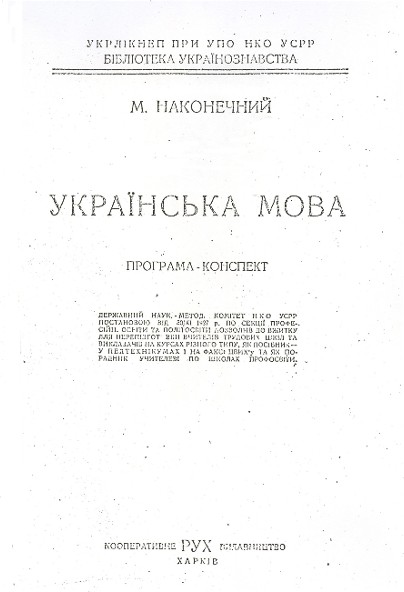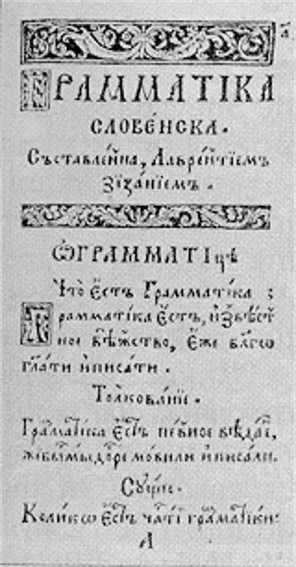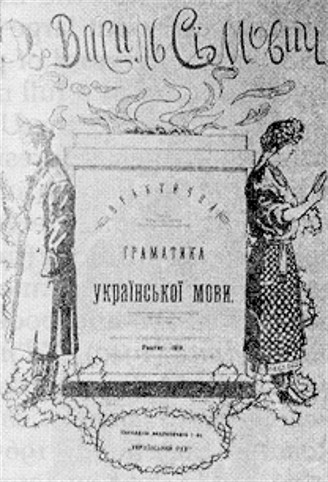Grammar
Grammar. The study of the formation of words, their inflections (morphology), and their functions and relations in the sentence (syntax). The first grammar known in Ukraine was an anonymous translation and adaptation of an unfinished Greek grammatical treatise—‘O osmikh” chastikh” slova, elika pishem” i gl[ago]lem”’ (On the Eight Parts of Speech as Written and Spoken), the authorship of which was attributed without foundation in the Middle Ages to Saint John of Damascus and then to Ioann, the exarch of Bulgaria. The oldest extant manuscript copies of this grammar date from the 16th century and deal only with four parts of speech: the noun, verb, participle, and article. A 15th-century treatise on letters by the Bulgarian Serbian scholar Constantine the Grammarian from Kostenec was also used, though less widely, at the time. ‘On the Eight Parts of Speech’ became the model for the first Ukrainian printed grammars—Ivan Fedorovych (Fedorov)’s primer (1574) and Khramatyka sloven’ska iazyka (Grammar of the Slavic Language, 1586). It also had some impact on the more original, larger grammars of the late 16th and early 17th century, whose authors were part of the movement to restore and purify Church Slavonic. The most important were the Greek grammar Adelphotes (1591) and the grammars of Lavrentii Zyzanii (1596) and Meletii Smotrytsky (1619); the latter definitely influenced the form of Church Slavonic language in Ukraine, Russia, Serbia, and Croatia. None of these grammars dealt with the vernacular, but only with the language of church ritual and theological writings.
The philosophical-rationalist grammar that became influential in Western Europe at that time had a very limited impact in Ukraine because of the cultural dominance of the church in the 17th century and the general decline of cultural life in the 18th century. Even in the first half of the 19th century ecclesiastical, bookish traditions prevailed in Galicia and Transcarpathia. The grammars of Mykhailo Luchkai (1830), Yosyp Levytsky (1834), and Ivan Vahylevych (1845) still retained much of the Church Slavonic tradition. The influence of the Romantic approach spread slowly; it was applied hesitantly at first in the grammars of Oleksii Pavlovsky (written before 1805 and published in 1818), Ivan Mohylnytsky (written before 1824), and Yosyp Lozynsky (written before 1833 and published in 1846). Thereafter the Romantic approach, which focused on the distinctive features of the folk vernacular as the immutable expressions of the ‘spirit of a people,’ became a long-standing tradition in Ukrainian grammar and led to an insistence on the preservation and development in the language of all that was ‘native’ and ‘natural’ at the expense of that which was ‘bookish,’ ‘false.’
The positivist-comparative approach to the study of the Slavic languages, including the Ukrainian language, began spreading after the publication of Vergleichende Grammatik der slavischen Sprachen (vol 1, 1852) by the Slovenian scholar Franz Miklosich. This new approach was combined with the Romantic one in Omelian Ohonovsky's Studien auf dem Gebiete der ruthenischen Sprache (1880); in Pavlo Zhytetsky's Ocherk zvukovoi istorii malorusskogo narechiia (Outline of the Historical Phonology of the Little Russian Dialect, 1876); in the first Galician Ukrainian school grammars, by Mykhailo Osadtsa (1862, 1864, 1876), Hryhorii Shashkevych (1865), P. Diachan (1865), and Omelian Partytsky (1873); and even in the first school grammars in Russian-ruled Ukraine, which were permitted to appear after 1905, by Petro Zalozny (pt 1, 1906, 1912, 1917; pt 2, 1913), Hryhorii Sherstiuk (pt 1, 1907, 1912, 1917; pt 2, 1909, 1917), Yevhen Tymchenko (1907, 1917), Ahatanhel Krymsky (1907), Ivan Nechui-Levytsky (1914), and Olena Kurylo (1917). While Oleksander Potebnia transcended the eclectic, Romantic, and positivist (neogrammarian) combination of approaches found in the books of his predecessors in his synthesizing works on historical syntax, Stepan Smal-Stotsky and Theodor Gartner attempted, in their Grammatik der ruthenischen (ukrainischen) Sprache (1913), to defend the essentially Romantic approach by means of the neogrammarian method, in a rather mechanical way.
During the period from 1917 to 1933 in Soviet Ukraine, when the Ukrainian literary language underwent substantial standardization (see Standard Ukrainian), the Romantic approach became more and more obviously puristic. This is evident in such works as Olena Kurylo's Uvahy do suchasnoï ukraïns’koï literaturnoï movy (Commentaries on the Contemporary Ukrainian Literary Language, 1920, 1923, 1925), Vasyl Simovych's Ukrainian grammars (1919, 1921), Ivan Ohiienko's Chystota i pravyl’nist’ ukraïns’koï movy (The Purity and Correctness of the Ukrainian Language, 1925), and especially in Serhii Smerechynsky's Narysy z ukraïns’koï syntaksy (Essays on Ukrainian Syntax, 1932) and Yevhen Tymchenko's monographs on functions of grammatical cases (1913–28). In this period most grammar textbooks were also written from the purist perspective (eg, by Hryhorii Ivanytsia, M. Hladky, O. Kurylo, Petro Horetsky, Ivan Shalia). A less radically romantic and puristic approach is represented in Oleksa Syniavsky's works, such as Normy ukraïns’koï literaturnoï movy (The Norms of the Ukrainian Literary Language, 1931), in Pidvyshchenyi kurs ukraïns’koï movy (An Advanced Course in the Ukrainian Language, 1930, prepared by Leonid Bulakhovsky's followers and edited by him), and in textbooks by Syniavsky, Mykola Sulyma, Maik Yohansen, Mykola Nakonechny, and others.
In the early 1930s such scholars as Olena Kurylo and Syniavsky became interested in structural linguistics, but this development was cut short by the Stalinist terror and the suppression of Ukrainian culture. It has been manifested outside Ukraine, however, in Vasyl Simovych's articles and in George Yurii Shevelov's Narys suchasnoï ukraïns’koï literaturnoï movy (An Outline of the Contemporary Ukrainian Standard Language, 1951). In Ukraine the compulsory method in grammar since the 1930s has been based on a combination of revived logicist-rationalist theory and political propaganda; most books of that time have served to Russify the Ukrainian literary language. The best works published there in the past 50 years are Kurs suchasnoï ukraïns’koï literaturnoï movy (A Course in the Contemporary Ukrainian Literary Language, 1951), edited by Leonid Bulakhovsky, and three volumes of Suchasna ukraïns’ka literaturna mova (The Contemporary Ukrainian Literary Language, 1969–72), edited by Ivan Bilodid. (See also Lexicology.)
George Yurii Shevelov
[This article originally appeared in the Encyclopedia of Ukraine, vol. 2 (1989).]


 title page.jpg)

.jpg)